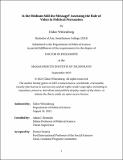Is the Medium Still the Message? Assessing the Role of Video in Political Persuasion
Author(s)
Wittenberg, Chloe
DownloadThesis PDF (4.941Mb)
Advisor
Berinsky, Adam J.
Terms of use
Metadata
Show full item recordAbstract
Video is a central—and growing—part of the American political landscape. Whether via televised news programs, campaign advertising, or social media posts on YouTube and TikTok, members of the public now have access to a colossal amount of audiovisual content about politics, distributed across myriad platforms. Yet despite the ubiquity of political video in contemporary life, scholars still lack a firm understanding of whether, and in what ways, individuals’ processing of such content differs from their processing of more traditional media, such as text. To answer these questions, I draw on a range of data sources, including eight original survey experiments, spanning over 20,000 U.S. adults and more than 150 unique messages, as well as a large dataset of political posts published on Facebook over a five-year period. In the first part of the dissertation, conducted in collaboration with Ben Tappin, Adam Berinsky, and David Rand, I document an intriguing disconnect between a message's credibility and persuasiveness: although political videos tend to be perceived as substantially more believable, compared to corresponding transcripts, they generate only marginally more attitude change. In the second part of the dissertation, I then assess whether these patterns persist over time. Using a two-wave longitudinal study, I demonstrate that members of the public generally revise their political opinions in response to new information, regardless of whether this information is presented in the form of video or text—with persuasion visible across both modalities immediately after exposure and several days later. Finally, in the last part of the dissertation, I shift my focus from political attitudes to personal engagement. Observationally, I find that political videos tend to attract more interest and attention on social media, compared to text-based news articles. However, within a more controlled experimental setting, members of the public do not display a consistent preference for video when deciding what types of political media to consume and share online. Together, these findings offer new insights about the nature of political information processing in an increasingly multimodal media environment.
Date issued
2023-09Department
Massachusetts Institute of Technology. Department of Political SciencePublisher
Massachusetts Institute of Technology